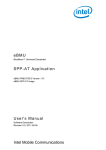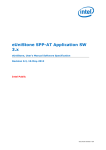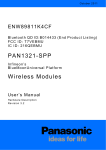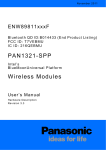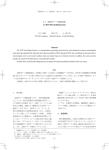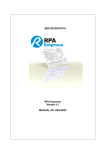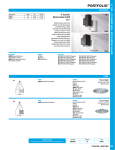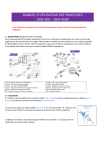Download eBMU User`s Manual
Transcript
October 2008 eBMU BlueMoon™ Universal Embedded SPP-AT Application eBMU (PMB 8753/2), Version 1.01 eBMU SPP-AT, Version 1.1 User's Manual Software Description Revision 2.0 Communication Solutions SPP-AT User's Manual Software Description downloaded by Annakarin Ericson (Infineon Technologies Sweden) at 22 Jan 2009 11:07 Edition 2008-10-21 Published by Infineon Technologies AG 81726 Munich, Germany © 2008 Infineon Technologies AG All Rights Reserved. Legal Disclaimer The information given in this document shall in no event be regarded as a guarantee of conditions or characteristics. With respect to any examples or hints given herein, any typical values stated herein and/or any information regarding the application of the device, Infineon Technologies hereby disclaims any and all warranties and liabilities of any kind, including without limitation, warranties of non-infringement of intellectual property rights of any third party. Information For further information on technology, delivery terms and conditions and prices, please contact the nearest Infineon Technologies Office (www.infineon.com). Warnings Due to technical requirements, components may contain dangerous substances. For information on the types in question, please contact the nearest Infineon Technologies Office. Infineon Technologies components may be used in life-support devices or systems only with the express written approval of Infineon Technologies, if a failure of such components can reasonably be expected to cause the failure of that life-support device or system or to affect the safety or effectiveness of that device or system. Life support devices or systems are intended to be implanted in the human body or to support and/or maintain and sustain and/or protect human life. If they fail, it is reasonable to assume that the health of the user or other persons may be endangered. SPP-AT User's Manual Software Description downloaded by Annakarin Ericson (Infineon Technologies Sweden) at 22 Jan 2009 11:07 eBMU PMB 8753/2 eBMU Revision History: 2008-10-21, Revision 2.0 Previous Version: PMB8753-2_SPP_AT_specification_R2.pdf Chapter Subjects (major changes since last revision) Pull up and tri-state acronyms added 2 Master slave role switch added 3 4.2 Default state for GPIO, info added 4.1.2.1.1 4.1.2.1.2 Changes in command status values 4.2 • • • • • • • • • 4.3 5 General error messages updated AT+JCAC GPIO parameter explanation linked to corresponding section AT+JGPA reserved parameter info added, response info expanded AT+JCCR change in the response info about ERR=0 AT+JSDA Values range: 1-MTU added, MTU maximum value changed AT+JDDS Change in the parameter values AT+JPCR Change in the response, +RSLE is received now +RDII info on link lost while in stream mode added +RRSI Master/Slave role switch indication added +RPCI example MTU value changed to 230 in examples Template: com_template_20080527.dot / 2.32 / 2008-05-27 SPP-AT User's Manual Software Description downloaded by Annakarin Ericson (Infineon Technologies Sweden) at 22 Jan 2009 11:07 eBMU PMB 8753/2 Trademarks of Infineon Technologies AG ABM™, A-GOLD™, AOP™, BlueMoon™, CONVERGATE™, CONVERPATH™, COSIC™, C166™, DUALFALC™, DUSLIC™, E-GOLD™, ELASTec™, EPIC™, FALC™, FLEXISLIC™, GEMINAX™, GOLDMOS™, INCA™, IOM™, IPVD™, ISAC™, IWE™, IWORX™, M-GOLD™, MUSLIC™, OCTALFALC™, OCTAT™, OMNITUNE™, OMNIVIA™, OPTIVERSE™, PASi™, PROSOC™, QUADFALC™, SCEPTRE™, SCOUT™, SEROCCO™, S-GOLD™, SICOFI™, SIEGET™, SLIC™, SMARTi™, SMARTiPM™, SMARTiPM+™, SMARTiUE™, SMARTi3G™, SMARTi3G+™, SMINT™, SOCRATES™, TRUENTRY™, VINAX™, VINETIC™, VIONTIC™, VOIPRO™, WDCT™, WildPass™, X-GOLD™, XMM™, X-PMU™, XWAY™. Other Trademarks ® ® ® ® ® Microsoft , Visio , Windows of Microsoft Corporation. Linux of Linus Torvalds. FrameMaker of Adobe ® ® ® ® Systems Incorporated. APOXI , COMNEON™ of Comneon GmbH & Co. OHG. PrimeCell , RealView , ARM , ® ARM Developer Suite™ (ADS), Multi-ICE™, ARM1176JZ-S™, CoreSight™, Embedded Trace Macrocell™ ® (ETM), Thumb , ETM9™, AMBA™, ARM7™, ARM9™, ARM7TDMI-S™, ARM926EJ-S™ of ARM Limited. ® ® ® OakDSPCore , TeakLite DSP Core, OCEM of ParthusCeva Inc. IndoorGPS™, GL-20000™, GL-LN-22™ of Global Locate. mipi™ of MIPI Alliance. CAT-iq™ of DECT Forum. MIPS™, MIPS II™, 24KEc™ of MIPS ® Technologies, Inc. Texas Instruments , PowerPAD™, C62x™, C55x™, VLYNQ™, Telogy Software™, ® TMS320C62x™, Code Composer Studio™, SSI™ of Texas Instruments Incorporated. Bluetooth of Bluetooth ® SIG, Inc. IrDA of the Infrared Data Association. Java™, SunOS™, Solaris™ of Sun Microsystems, Inc. ® ® ® ® Philips , I2C-Bus of Koninklijke Philips Electronics N.V. Epson of Seiko Epson Corporation. Seiko of ® ® Kabushiki Kaisha Hattori Seiko Corporation. Panasonic of Matsushita Electric Industrial Co., Ltd. Murata of ® Murata Manufacturing Company. Taiyo Yuden™ of Taiyo Yuden Co., Ltd. TDK of TDK Electronics Company, ® ® Ltd. Motorola of Motorola, Inc. National Semiconductor , MICROWIRE™ of National Semiconductor ® ® ® Corporation. IEEE of The Institute of Electrical and Electronics Engineers, Inc. Samsung , OneNAND , ® ® ® ® UtRAM of Samsung Corporation. Toshiba of Toshiba Corporation. Dallas Semiconductor , 1-Wire of Dallas ® Semiconductor Corp. NOVeA™ of Virage Logic Corp. ISO of the International Organization for ® Standardization. IEC™ of the International Engineering Consortium. EMV™ of EMVCo, LLC. Zetex of Zetex ® ® Semiconductors. Rohm™ of Rohm Co., Ltd. Microtec of Microtec Research, Inc. Verilog of Cadence Design ® ® ® Systems, Inc. ANSI of the American National Standards Institute, Inc. WindRiver and VxWorks of Wind River ® Systems, Inc. Nucleus™ of Mentor Graphics Corporation. OmniVision of OmniVision Technologies, Inc. ® ® ® Sharp of Sharp Corporation. Symbian OS of Symbian Software Ltd. Openwave of Openwave Systems, Inc. ® Maxim of Maxim Integrated Products, Inc. The information in this document is subject to change without notice. Last Trademarks Update 2008-05-27 Template: com_template_20080527.dot / 2.32 / 2008-05-27 SPP-AT User's Manual Software Description downloaded by Annakarin Ericson (Infineon Technologies Sweden) at 22 Jan 2009 11:07 eBMU PMB 8753/2 Table of Contents Table of Contents 1 Introduction ........................................................................................................................................6 2 Bluetooth Features ............................................................................................................................7 3 3.1 3.1.1 3.1.2 3.2 Serial Port Profile ...............................................................................................................................8 Operation Modes..................................................................................................................................8 Command Mode...................................................................................................................................8 Stream Mode........................................................................................................................................8 PIN Assignments..................................................................................................................................8 4 4.1 4.1.1 4.1.2 4.1.2.1 4.1.2.1.1 4.1.2.1.2 4.2 4.3 4.4 4.5 4.5.1 4.5.2 4.6 4.7 4.8 4.9 4.10 Infineon SPP-AT Command and Response.....................................................................................9 AT Command and Response Format and Syntax ...............................................................................9 AT-commands ....................................................................................................................................10 AT-responses .....................................................................................................................................10 AT Response Parameter List for <status> and <ERROR> ...............................................................10 Command Execution Status Values ..................................................................................................10 General Error Messages ....................................................................................................................10 AT Command List Table ....................................................................................................................11 AT Responses List (not command triggered) ....................................................................................18 Crystal Auto Calibration (Frequency counter method).......................................................................19 Low Power Mode Control...................................................................................................................19 Host Initiates Low Power Mode Entry and Exit ..................................................................................20 Host Initiates Low Power Mode Entry, eBMU Initiates Exit ...............................................................20 UART Baud Rate Change..................................................................................................................21 Data Flow Control ..............................................................................................................................21 Production Mode ................................................................................................................................21 SPP-AT Commands Operating with EEPROM..................................................................................22 Security Mode ....................................................................................................................................22 5 Example AT Commands and Responses ......................................................................................23 References ...........................................................................................................................................................26 Terminology .........................................................................................................................................................27 User's Manual Software Description 5 Revision 2.0, 2008-10-21 SPP-AT User's Manual Software Description downloaded by Annakarin Ericson (Infineon Technologies Sweden) at 22 Jan 2009 11:07 eBMU PMB 8753/2 Introduction 1 Introduction This document describes the AT commands applicable to Infineon’s eBMU Bluetooth solution for embedded applications. The product utilizes a raw AT set of commands and responses over UART for Bluetooth communications and control on an embedded device. User's Manual Software Description 6 Revision 2.0, 2008-10-21 SPP-AT User's Manual Software Description downloaded by Annakarin Ericson (Infineon Technologies Sweden) at 22 Jan 2009 11:07 eBMU PMB 8753/2 Bluetooth Features 2 • • • • • • • • • • • • • • Bluetooth Features Bluetooth v2.0 + EDR compliant. Device A and B support 1 ACL link with stream or command mode. Device A and B - Visible while connected. Device A and B - Visible/connectable when not connected. Device A and B - Device Discovery capable after receiving OK on data transfer. Sniff mode is supported with above capabilities. 5 trusted devices stored in EEPROM. Testing Enable DUT. Crystal calibration. H4 with UART HW flow control (RTS/CTS). Security modes Mode 1 and Mode 3. Master-Slave role switch User's Manual Software Description 7 Revision 2.0, 2008-10-21 SPP-AT User's Manual Software Description downloaded by Annakarin Ericson (Infineon Technologies Sweden) at 22 Jan 2009 11:07 eBMU PMB 8753/2 Serial Port Profile 3 Serial Port Profile Host communication sent over UART is always called command except while in stream mode, see below. All communication received by host application over UART is called response except while in stream mode. 3.1 Operation Modes The specification defines two operation modes of the PMB 8753/2 also named eBMU throughout the document. For Bluetooth SPP there are two different roles specified; A-device (paging device) setting up the over the air connection and B-device which is connectable and accepts the connection (page scanning device). 3.1.1 Command Mode In this mode the SPP application running on the eBMU will execute the AT commands sent from the host over the UART using the H4 UART protocol as specified within the Bluetooth SIG [1]. In this mode, the host application can send data to the eBMU, which are transmitted to the remote device which has a Bluetooth connection on SPP level with the eBMU. This mode is normally used when transmitting burst and packetized data. Setting up/accepting Bluetooth SPP connections and/or searching for other Bluetooth devices are also operations done in this mode. 3.1.2 Stream Mode In this mode, the host application will send un-packetized data to the eBMU, which are transmitted over the air to the remote device. This mode is normally used when transmitting small size of data in a random way and for serial cable replacement applications. 3.2 PIN Assignments The table below shows the available GPIOs. GPIOs noted with “(Reserved)” can not be controlled by a host. P0.1 and P0.8 can be used as application GPIOs but not when they are used during the crystal calibration procedure. All application GPIOs are by default configured as tri-state. User's Manual Software Description 8 Revision 2.0, 2008-10-21 SPP-AT User's Manual Software Description downloaded by Annakarin Ericson (Infineon Technologies Sweden) at 22 Jan 2009 11:07 eBMU PMB 8753/2 Infineon SPP-AT Command and Response PIN name Direction GPIO Description UART_RX UART_TX UART_RTS UART_CTS Default Configuration I O PU O PU I I O O I P0.5 (Reserved) P0.4 (Reserved) P0.6 (Reserved) P0.7 (Reserved) UART UART UART UART SDA SCL O PU I PU I/O I P0.12 (Reserved) P0.13 (Reserved) I2C I2C PCMFR1 TX_Conf2 O PU I O I P0.0 (Reserved) P0.14 (Reserved) LPM LPM PCMCLK PCMIN PCMOUT PAON PSEL0 PSEL1 TX_Conf1 P015 Z Z Z Z Z Z Z Z I/O I/O I/O I/O I/O I/O I/O I/O P0.1 P0.2 P0.3 P0.8 P0.9 P0.10 P0.11 P0.15 APPL GPIO / XTAL CAL APPL GPIO APPL GPIO APPL GPIO / XTAL CAL APPL GPIO APPL GPIO APPL GPIO APPL GPIO 4 Infineon SPP-AT Command and Response AT commands can only be sent while in command mode with the exception of stream connection cancel (^^^) which can be sent in stream mode. The expected response after sending an AT command is the “OK” response, see specification below. The host shall wait for a command to be terminated before sending a new one. A command is considered as terminated when “OK” and all subsequent related responses have been received. There are also responses, which are not initiated by a sent command. They are in that case initiated by the remote Bluetooth device. 4.1 AT Command and Response Format and Syntax All data exchanged between the host and eBMU is in ASCII format. Parameters for commands and responses are given in decimal (DEC) base in ASCII format unless hexadecimal (HEX) base is specified. MSB is always sent first. eBMU does not distinguish between upper and lower cases. Example for values with decimal base in ASCII format The number 255 in decimal corresponds to the following three characters AT+JSDA=010,1234567890 (the number 10 is given by three ASCII characters ‘0’, ‘1’, ‘0’. ‘2’, ‘5’, ‘5’. E.g. Example for values with hexadecimal base in ASCII format The number 255 in decimal base corresponds to the number FF in hexadecimal base, thereby the number in ASCII format for hexadecimal base is represented by the following two characters ‘F’, ‘F’. User's Manual Software Description 9 Revision 2.0, 2008-10-21 SPP-AT User's Manual Software Description downloaded by Annakarin Ericson (Infineon Technologies Sweden) at 22 Jan 2009 11:07 eBMU PMB 8753/2 Infineon SPP-AT Command and Response E.g. +RSNFCNF=3E80,2 ; The four ASCII characters ‘3’, ‘E’, ‘8’, ‘0’ represent the number 3E80 in hexadecimal base which corresponds to 16000 in decimal base. 4.1.1 AT-commands All AT-commands follow the format below; AT+<command>=<parameter 1 (if required)>,<parameter 2 (if required)>,<parameter 3 (if required)> ,<…><carriage return><line feed> E.g.: AT+JCCR=0010c64d67dc,01 (to connect to BD_ADDR “0010c64d67dc”, service channel 1) 4.1.2 AT-responses All AT-responses follow the format below with the exception of <OK> and <ERROR=>; +<response>=<parameter 1 (if required)>,<parameter 2 (if required)>,<parameter 3 (if required)>,<…><carriage return><line feed> E.g.: +RDAI =004,DATA ( 4 bytes (“DATA”) received) 4.1.2.1 4.1.2.1.1 AT Response Parameter List for <status> and <ERROR> Command Execution Status Values Values for <status> general for all commands • • • BT_OK BT_ERROR BT_TIMEOUT 4.1.2.1.2 • • 1. 2. 3. 4. 5. 6. 7. 8. 0 1 4 General Error Messages ERR = -1; Syntax Error ERR = -2; Command not allowed at present execution status − ERR=-2 is obtained when any of the following situations is met: Create a new connection when already connected. Device discovery when already connected. Send data when not connected. Accept connection request without a request. Enter sniff mode without being connected. Enable SEC mode after another command has previously been sent. Service discovery when connected. Send data with length = 0. User's Manual Software Description 10 Revision 2.0, 2008-10-21 SPP-AT User's Manual Software Description downloaded by Annakarin Ericson (Infineon Technologies Sweden) at 22 Jan 2009 11:07 eBMU PMB 8753/2 Infineon SPP-AT Command and Response 4.2 AT Command List Table AT Command AT+JAAC=<auto_accep t> Usage Resulting response(s) from eBMU DevA / Dev B Auto Accept Connection requests Forces eBMU to accept connection requests. OK Dev B OK Dev B OK Dev A Dev B +RCACCNF=<osc_trim> osc_trim parameter(4 octets / HEX base) Dev A Dev B auto_accept parameter (1 octet ): 0 – Host will be notified on incoming connection indication (+RCOI) – (no auto accept). Default value 1 – eBMU will automatically auto accept incoming connection request – (host will be notified but connection is accepted automatically) AT+JACR= <accept> AT+JEDT Accept Connection Request Shall be used as answer to a connect indication (+RCOI). accept parameter (1 octet): 0 – Not accepted 1 – Accepted Enable Device under Test This SPP-AT command enables the device under test. After this command has been sent it is possible for a remote tester to connect, this AT command corresponds to the three different HCI commands listed below: 1. Set Event Filter – allow all connections. 2. Write Scan Enable – page and Inquiry. 3. Enable device under test. Note: JEDT command can only be issued with security mode 1 and after production mode is enabled (JPRO=1). See section 4.8. AT+JCAC=<trim_value>,< GPIO > Crystal Auto Calibrate trim_value parameter (4 octets / HEX base): The trim value is used to adjust the frequency on the GPIO chosen by the GPIO parameter. GPIO parameter (4 octets / HEX base): Two GPIOs can be used as output for the oscillator trim, P01 and P08 (0002 and 0100). See section 4.4. AT+JCBD=<bd_data> User's Manual Software Description Note: JCAC command can only be issued after production mode is enabled (JPRO=1). See section 4.8. Change BD_Data bd_data parameter (116 octets / HEX base): (reference values) msg.bdAddr (12 octets)= see note1 msg.channelWordOffset (4 octets) =0000; msg.clkConf (2 octets)= 8A; msg.eepromSize (2 octets)=80; 11 Use AT+JCBD to store the osc_trim value to EEPROM. OK Dev A Dev B Revision 2.0, 2008-10-21 SPP-AT User's Manual Software Description downloaded by Annakarin Ericson (Infineon Technologies Sweden) at 22 Jan 2009 11:07 eBMU PMB 8753/2 Infineon SPP-AT Command and Response AT Command Usage Resulting response(s) from eBMU DevA / Dev B OK (Followed by): +RCCRCNF=<MTU_size>,< status> MTU_size parameter (3 octets / DEC base) status parameter (1 octet) Dev A msg.inputFreq (8 octets)=018CBA80; msg.lmpFeatures (16 octets)=000019987E0602BF; msg.lpmConf (2 octets)=40; msg.lpmDrift (2 octets)=FA; msg.lpmThreshold (2 octets)=12; msg.ulpmThreshold (2 octets)=18; msg.pmuConfig (4 octets)=0080; msg.rfPselD (8 octets)=06050403; msg.rfPselConf (2 octets)=44; msg.rssiMin (2 octets)=0C; msg.rssiMax (2 octets)=10; msg.ddcTlConf (2 octets)=02; msg.uartBaudrate (2 octets)=04; msg.uartInvert (2 octets)=00; msg.uartPulls (2 octets)=01; msg.oscSettle (2 octets)=08; msg.bbConf (2 octets)=04; msg.rfConf (2 octets)=04; msg.txPowerRef0 (2 octets)=F2; msg.txPowerRef1 (2 octets)=F8; msg.txPowerRef2 (2 octets)=FE; msg.txPowerRef3 (2 octets)=04; msg.oscTrim (4 octets)=see note 2; msg.threeWireArqTimeout (2 octets)=06; msg.LMP_Version (2 octets)=00; msg.Reserved (16 octets)=0000000000000000; Note 1: This value shall be configured with the desired Bluetooth device Address (e.g. FFAA010203BB). Note 2: This value shall be configured with the value found during crystal calibration (see command AT+JCAC). AT+JCCR=<bd_addr>, <service channel> AT+JDDS=<limit_inquiry _result> User's Manual Software Description Note 3: JCBD command can only be issued after production mode is enabled (JPRO=1). Changes in BD Data take place after production mode command is disabled (JPRO=0) followed by a SW reset (AT+JRES). See section 4.8. Create Connection Request Instructs eBMU to connect to a remote Bluetooth device (prospective slave). bd_addr parameter (12 octets / HEX base): The Bluetooth address of the remote device service_channel parameter (2 octets / DEC base): 0-30 Which service channel to connect to can be received from a Service Discovery (AT+JSDS) Device Discovery Start Causes eBMU to start a Device Discovery (Inquiry and Remote Name Request) of the Bluetooth neighborhood. 12 If maximum number of allowed connections already exists: ERR=-2. OK (Then, if responses are returned): +RDDSRES=< bd_addr ><remote_name>,<COD> (For each response) Dev A Revision 2.0, 2008-10-21 SPP-AT User's Manual Software Description downloaded by Annakarin Ericson (Infineon Technologies Sweden) at 22 Jan 2009 11:07 eBMU PMB 8753/2 Infineon SPP-AT Command and Response AT Command Usage Resulting response(s) from eBMU limit_inquiry_result parameter (1 octet): Values range: 0-1. The maximum number of responses that can be obtained is 8. Note: values in the limit_inquiry_result parameter have no impact in the behavior of the command. AT+JDIS=<discoverable > DIScoverable Forces eBMU into Page Scan / Inquiry Scan states indefinitely (note: this makes the device discoverable). bd_addr parameter (12 octets / HEX base). remote_name parameter (variable length): Name of the remote device. Page Timeout is received as a name if the remote name is not found during device discovery COD parameter (6 octets / HEX base). Class of device (Completed by): +RDDSCNF=<status> status parameter (1 octet) OK AT+JDOI File open and send in binary format after “OK” is received. AT+JGPA=<reserved>, <read>, <set>,<clear> Note: JDOI command can only be issued after production mode is enabled (JPRO=1). Changes in the EEPROM image are effective after production mode command is disabled (JPRO=0) followed by a HW reset. See section 4.8. GPIO action All parameters of this command are bit fields of 16 bits corresponding to GPIOs P0.15 to P0.0. E.g. if pin P0.0 is the desired bit; the bit field value is 0001 and if the desired bit is P0.12 the bit field value is 0800. reserved parameter (4 octets) read parameter (4 octets / Hex base): Values for each bit: 0- No Action 1- Read set parameter (4 octets / HEX base): Values for each bit: 0- No Action 1- Set clear parameter (4 octets / HEX base): Values for each bit: User's Manual Software Description 13 Dev B Dev A is discoverable but does not accept incoming connections. discoverable parameter (1 octet): 0- No scans enabled. 1- Inquiry Scan enabled. 2- Page Scan enabled. 3- Inquiry & Page Scan enabled. Note: Default value after a HW reset is no scans enabled DOwnload Application Image via UART After “OK” response a binary file with the EEPROM image should be sent. DevA / Dev B OK after command is sent. Dev A Dev B +RDOICNF after .eep file has been written. Note: eBMU calculates the size of the image that is being downloaded from the file header. The response +RDOICNF is generated when the calculated size is reached. +GPOACNF=<value> Dev A Dev B value parameter (4 octets / HEX base): This value is the state of the GPIO PINs specified in read parameter. Values for each bit: 0 – means low. 1 – means high. When the pins are set as outputs the return value will be 0 for the specific pin. Reserved pins will always return 0 Revision 2.0, 2008-10-21 SPP-AT User's Manual Software Description downloaded by Annakarin Ericson (Infineon Technologies Sweden) at 22 Jan 2009 11:07 eBMU PMB 8753/2 Infineon SPP-AT Command and Response AT Command AT+JGPC= <direction>,<open_drain>, <pull_on/off>,<pull_up/dow n>,<tristate> Usage 0- No Action 1Clear GPIO Configuration All parameters of this command are bit fields of 16 bits corresponding to GPIOs P0.15 to P0.0 (See command AT+JGPA). Resulting response(s) from eBMU DevA / Dev B OK Dev A Dev B OK (Followed by): +RSLE if secure established Dev A Dev B direction parameter (4 octets / HEX base): Values for each bit: 1 - IN 0 - OUT open_drain parameter (4 octets / HEX base): Values for each bit: 1 - OPEN pull_on/off parameter (4 octets / HEX base): Values for each bit: 1 - Pull ON 0 - Pull OFF pull_up/down parameter (4 octets / HEX base): Value for each bit: 1 - Pull UP tristate parameter (4 octets / HEX base): Value for each bit: 1 - Tri-state AT+JPCR=<length_PIN_c ode>, <PIN_code> Note: See section 3.2 for available GPIO pins. PIN Code Reply Sent to eBMU in response to a PIN Code Request from a remote Bluetooth device (bd_addr). link is length_PIN_code parameter (2 octets / DEC base): Values= 1-16 Length of PIN code PIN_code parameter (length= length_PIN_code): The PIN Code to be sent to the remote Bluetooth device, e.g. AT+JPCR=04,1234 AT+JPRO=<mode> AT+JRBD Note: the PIN code is an ACII string. PROduction mode mode parameter (1 octet): 1= Production mode ON 0= Production mode OFF Note: See section 4.8 for commands requiring production mode. Read Bluetooth device Data Sent to eBMU to retrieve the Bluetooth Device Address and the Oscillator trimming value. OK Dev A Dev B +RRBDRES=<bd_addr>,< oscTrim> Dev A Dev B bd_addr parameter (12 octets / HEX base): BD Address of remote device oscTrim parameter (4 octets User's Manual Software Description 14 Revision 2.0, 2008-10-21 SPP-AT User's Manual Software Description downloaded by Annakarin Ericson (Infineon Technologies Sweden) at 22 Jan 2009 11:07 eBMU PMB 8753/2 Infineon SPP-AT Command and Response AT Command AT+JRES AT+JRLS=<uuid>, <length_ service_name > <service_name>,<service channel >, <CoD> AT+JRRI AT+JRTD=<bd_addr> AT+JSCR AT+JSDA=<length>,<data > Usage Resulting response(s) from eBMU DevA / Dev B RESet SW reset of the system. Register Local Service / HEX base) Oscillator trim value ROK as applications is restarted. OK Dev A Dev B Dev B uuid parameter (4 octets / HEX base ): uuid for supported profile e.g.1101 for Serial Port Profile length_service_name parameter (2 octets / DEC base): Values=1-16 Length of service name service_name parameter (length= length_service_name): Name for the service, no final delimiter is needed service channel parameter (2 octets / DEC base): Values range: 0-30 Which service channel to connect to; can be received from a Service Discovery with AT+JSDS CoD parameter (6 octets / HEX base) Class of device. The default CoD value is 000000 Read Revision Information +RRRICNF=<revision> Remove Trusted Device – deletes the trusted device information for a registered device (bd_addr). bd_addr parameter (12 octets / HEX base): The Bluetooth address of the device that shall be removed from the list Stream Connection Request Connects the SPP and UART streams, transparent communication will be enabled if both sides execute this command. Send Data Request revision parameter (2 octets / HEX base) OK Dev A Dev B Dev A Dev B OK Dev A Dev B OK Dev A Dev B OK Dev A Dev B OK (Then, if services are returned): +RSDSRES=<remote_servic Dev A length parameter (3 octets / DEC base): number of bytes to be sent Values range: 1-MTU data parameter (see note for size): data to be sent AT+JSDR AT+JSDS=<bd_addr>,< uuid> User's Manual Software Description Note: Maximum number of bytes for each packet is reported at connection confirmation (MTU_Size) MTU size for eBMU is 230 bytes but this parameter is negotiated under connection set up. SPP Disconnect Request Forces an SPP disconnection. Service Discovery Start Causes eBMU to start a service discovery of device with bd_addr and search for services defined by uuid. 15 Revision 2.0, 2008-10-21 SPP-AT User's Manual Software Description downloaded by Annakarin Ericson (Infineon Technologies Sweden) at 22 Jan 2009 11:07 eBMU PMB 8753/2 Infineon SPP-AT Command and Response AT Command Usage Resulting response(s) from eBMU bd_addr parameter (12 octets / HEX base): BD Address of remote device uuid parameter ( 4 octets / HEX base): Service to search for e.g. 1101 for Serial Port Profile AT+JSEC=<security_mode >,<Link_key_information>, <PIN_type>, <length_PIN_code>, <PIN_code> AT+JSLN=<length_frien dly_name>,<friendly_na me> AT+JSNF=<sniff_Max>, <sniff_Min>, <sniff_attempt>, <sniff_tmo>,<on/off> User's Manual Software Description e name>,<remote_service_cha nnel> remote_service_name parameter (variable length): Name of the remote service. remote_service_channel parameter (2 octets / DEC base) (For each service) (Completed by): +RSDSCNF=<status> status parameter (1 octet) OK Enable SECurity DevA / Dev B Dev A Dev B security_mode parameter (1 octet): 1- Security Mode 1 2- N/A 3- Security Mode 3 (default) link_key_information parameter (1 octet): 1- Inform about link key 2- Don’t inform about link key (default) PIN_type parameter (1 octet) 1- Variable PIN 2- Fixed PIN length_PIN_code parameter (2 octets / DEC base): Length of PIN code. The maximum PIN length value is 16 ( corresponding to a 16 octets long PIN code) PIN_code parameter (length=length_PIN_code): Normal user PIN, for example “0000” (default), This parameter is taken into account if PIN_TYPE is fixed. Note: If security mode shall be changed from default settings, AT+JSEC shall be the first command that is sent after a reset. Security mode 3 is the default security mode and the default PIN type is variable. Set Local device friendly Name Supports all ASCII characters. OK Dev A Dev B +RSNFCNF= <sniff_Interval>,<mode> Dev A Dev B length_friendly_name parameter (2 octets / DEC base): Length of friendly name, the maximum value for length is 18. friendly_name parameter (length=length_friendly_name): No delimiter is required. Sniff Request Request a link to enter Sniff Mode. All command parameters are given in HEX base with the exception of on/off parameter. 1 ASCII character represents four bits in HEX base e.g. “A” is 1010. MSB given first. 16 sniff_Interval parameter (4 octets / HEX base): mode parameter (1 octet): One octet to indicate normal mode (mode=0) or Revision 2.0, 2008-10-21 SPP-AT User's Manual Software Description downloaded by Annakarin Ericson (Infineon Technologies Sweden) at 22 Jan 2009 11:07 eBMU PMB 8753/2 Infineon SPP-AT Command and Response AT Command Usage Resulting response(s) from eBMU DevA / Dev B sniff mode (mode=2) ^^^ sniff_Max parameter (4 octets / HEX base): Maximum allowed sniff interval Value to be written= N Time = N * 0.625 msec Range: 1.25 msec to 40.9 s sniff_Min parameter (4 octets / HEX base): Minimum allowed sniff interval Value to be written= N Time = N * 0.625 msec Range: 1.25 msec to 40.9 s sniff_attempt parameter (4 octets / HEX base): Number of sniff attempts Value to be written= N Length = N* 1.25 msec Time Range: 0.625msec - 40.9 s sniff_tmo parameter (4 octets / HEX base): The time out value for sniff attempts Value to be written= N Time = N * 0.625 msec Range: 0 msec to 40.9 s on//off parameter (1 octet): One octet to indicate Sniff ON (value=1) or Sniff OFF (value=0) Stream Connection Cancel End Streaming Mode Send -T0 - ^ -T1- ^ -T1- ^ -T0- with an interval of T1= 1 second between symbols and T0 > 1second. OK Dev A Dev B Note: This string is not terminated with CR LF. User's Manual Software Description 17 Revision 2.0, 2008-10-21 SPP-AT User's Manual Software Description downloaded by Annakarin Ericson (Infineon Technologies Sweden) at 22 Jan 2009 11:07 eBMU PMB 8753/2 Infineon SPP-AT Command and Response 4.3 AT Responses List (not command triggered) AT Response Usage ROK Start up response +RPCI=<bd_addr> PIN Code Indication bd_addr parameter (12 octets / HEX base): MSB is sent first. +RCOI=<bd_addr> Dev A / Dev B Command to acknowledge the response Connect Indication AT+JPCR=<length_PIN_code >, <PIN_code> Dev A Dev B Dev A Dev B length_PIN_code parameter (2 octets / DEC base): Length of PIN code PIN_code parameter (length=length_PIN_code): AT+JACR= <accept> Dev B bd_addr parameter (12 octets / HEX base): See previous response for information on the format. accept parameter (1 octet): 0 – Not accepted 1 – Accepted Note: B should disable connectable mode +RDAI=<length>,<data> Data Indication Not available during stream mode. Dev A Dev B +RDII length parameter (3 octets / DEC base): number of bytes to be sent data parameter (length=length from previous parameter) Received data Disconnect Indication Received on the side that has not initiated the disconnection. Dev A Dev B During stream mode, if the link is lost, the response +RDDI is received after the link supervision time out which is 20 seconds long. +RSLE Secure Link Established +RSNFCNF=<sniff_Interval>,< mode> Sniff mode confirmation sniff_Interval parameter (4 octets / HEX base). +RRSI User's Manual Software Description mode parameter (1 octet): One octet to indicate Normal mode (mode=0) or sniff mode (mode=2) Role Switch Indication 18 Received on the side that has not issued the sniff command (AT+JSNF) Received when the remote device performs a Master/Slave role switch Dev A Dev B Dev A Dev B Dev A Dev B Revision 2.0, 2008-10-21 SPP-AT User's Manual Software Description downloaded by Annakarin Ericson (Infineon Technologies Sweden) at 22 Jan 2009 11:07 eBMU PMB 8753/2 Infineon SPP-AT Command and Response 4.4 Crystal Auto Calibration (Frequency counter method) The frequency of the eBMU's crystal oscillator can be calibrated with a built in capacitance array that is configured by the BD_DATA value Osc_trim. Instrument required is a frequency counter, for example Agilent 53131A universal counter. This method also requires that one of the GPIO pins P01 or P08 is available. The calibration will be done on a 32 MHz clock generated from the 26 MHz internal reference clock. This 32 MHz clock should be adjusted to be within ±2ppm (±64 Hz) accuracy. The command requires that the device is in production mode, please follow the sequence below: 1. Connect the frequency counter to the appropriate test point 2. Enter Production Mode AT+JPRO=1 3. Use The AT+JCAC command to define the test point and the Osc_trim value 4. Measure the frequency of the 32 MHz signal with the counter 5. Iterate steps 3 and 4 until ±2 ppm are reached. Then write the corresponding trim value to the parameter Osc_trim in the BD-data with AT+JCBD 6. Leave production mode AT+JPRO=0 7. Perform a SW reset 4.5 Low Power Mode Control The low power mode protocol for eBMU is based on hardware signaling only. No SPP commands or responses are required. The existing flow control signals for the UART are used together with two GPIOs to tell the other device (host or controller) when it may enter low power mode, when it should wake up and when it cannot transmit because the first device is in low power mode. Low power mode can be used when the device is in: • Page-/inquiry-scan mode • Connected with link in sniff • Disconnected In all other states low power mode shall not be used, a few examples of other states are listed below: • During connection set-up • During device discovery • ACL link without sniff To allow the eBMU to enter low power mode, the host sets PIN P0.14 low. When eBMU is ready, it will also allow the host to enter LPM by setting P0.0 low. Before entering LPM, the host shall set UART CTS of eBMU high. Before entering LPM, eBMU will set its own UART RTS high. The host can wake up eBMU by setting UART CTS of eBMU low again and setting P0.14 high again. eBMU can wake up the host by setting its own UART RTS low again and setting P0.0 high again. User's Manual Software Description 19 Revision 2.0, 2008-10-21 SPP-AT User's Manual Software Description downloaded by Annakarin Ericson (Infineon Technologies Sweden) at 22 Jan 2009 11:07 eBMU PMB 8753/2 Infineon SPP-AT Command and Response 4.5.1 Host Initiates Low Power Mode Entry and Exit The picture below describes when the host initiates Low Power Mode and host initiates the Low Power Mode. Host eBMU Host Output Host RTS GPIO 0.14 Host Input GPIO 0.00 Host CTS UARTRTS 1. 2. 3. 4. 5. UARTCTS The host allows eBMU to enter low power mode eBMU enters low power mode eBMU allows the host to enter low power mode, the host may, if it can, enter low power mode The host requests the eBMU to wake up eBMU wakes up 4.5.2 Host Initiates Low Power Mode Entry, eBMU Initiates Exit The picture below describes when the host initiates Low Power Mode and host initiates the Low Power Mode. Host eBMU Host Output Host RTS GPIO 0.14 Host Input GPIO 0.00 Host CTS UARTRTS 1. 2. 3. 4. 5. 6. UARTCTS The host allows eBMU to enter low power mode eBMU enters low power mode eBMU allows the host to enter low power mode The host enters low power mode eBMU requests the host to wake up The host wakes up User's Manual Software Description 20 Revision 2.0, 2008-10-21 SPP-AT User's Manual Software Description downloaded by Annakarin Ericson (Infineon Technologies Sweden) at 22 Jan 2009 11:07 eBMU PMB 8753/2 Infineon SPP-AT Command and Response 4.6 UART Baud Rate Change The baud rate of the UART can be changed by writing into the UART_Baudrate parameter of the BD_DATA. The available UART Baud rates are: UART Baud Rate (bauds/s) 9600 19200 38400 57600 115200 230400 460800 921600 1843200 3250000 Configuration value for BD_DATA 0 1 2 3 4 5 6 7 8 9 Procedure to change UART Baud Rate 1. Enter into production mode: AT+JPRO=1 2. Received confirmation from eBMU: OK 3. Write BD_Data command and specify the UART Baud Rate in the designated parameter according to the values provided above. 4. Exit production mode: AT+JPRO=0 5. Received confirmation from eBMU: OK 6. SW Reset Note: Original BD_Address and Osc_trim values need to be preserved. Read both with AT+JRBD command before changing the UART baud rate. 4.7 Data Flow Control eBMU acknowledges a data packet sent by send data command (AT+JSDA) with an “OK” response when it has been transmitted. The host shall wait for the acknowledgement before sending a new packet. 4.8 Production Mode Production mode is used for configuration and test purposes, the production mode shall be entered in order to execute the following commands: AT+JDOI: DOwnload EEPROM Image AT+JEDT: Enable Device under Test AT+JCAC: Crystal Auto Calibration AT+JCBD: Change BD_Data User's Manual Software Description 21 Revision 2.0, 2008-10-21 SPP-AT User's Manual Software Description downloaded by Annakarin Ericson (Infineon Technologies Sweden) at 22 Jan 2009 11:07 eBMU PMB 8753/2 Infineon SPP-AT Command and Response General procedure to use production mode related commands: 1. HW reset 2. Enter production mode (AT+JPRO=1) 3. Execute command (e.g. “AT+JDOI”) 4. Exit production mode (AT+JPRO=0) 5. HW reset 4.9 SPP-AT Commands Operating with EEPROM The following commands are related to operations (read/write) in the EEPROM: 1. AT+JDOI (Download Image): It writes the whole content of the EEPROM. 2. AT+JCBD (change BD_DATA): It writes the BD_DATA section of the EEPROM. 3. AT+JRTD (Remove Trusted Device). It erases the associated BD_ADDRESS and link-key from the EEPROM. 4. AT+JRLS (Register Local Service): It writes the CoD value into EEPROM. 5. AT+JCCR (Create connection with security mode 3): The resulting link key will be written into EEPROM (both in DEVA and DEVB). 6. AT+JRES (RESet): The content of EEPROM is read and loaded into RAM. 7. AT+JSLN (Set Local Name): The local name is written into EEPROM. Note: AT+JRBD does not read from EEPROM, but from the configuration that has been read into the device after startup. 4.10 Security Mode Pairing is done automatically when security mode 3 is used. Security mode 3 is the default security mode. If security mode 1 (no authentication and no encryption) is the desired mode, then AT+JSEC should be the first command issued specifying security mode 1 after a HW reset. The pair procedure involves a PIN code indication +RPCI and a secure link established response +RSLE. If a trusted device shall be removed, then the remove trusted device command (AT+JRTD) shall be used. See example in section 5 for a detailed session description. User's Manual Software Description 22 Revision 2.0, 2008-10-21 SPP-AT User's Manual Software Description downloaded by Annakarin Ericson (Infineon Technologies Sweden) at 22 Jan 2009 11:07 eBMU PMB 8753/2 Example AT Commands and Responses 5 Example AT Commands and Responses Example: Device Discovery Dev A Seq Direction Command /response No. 1. DevB Seq Direction Command /response 2. Host<-eBMU ROK 3. Host->eBMU AT+JDIS=3 4. Host<-eBMU OK 5. Host->eBMU AT+JRLS=1101,11,Serial port,01,000000 6. Host<-eBMU OK Direction Command /response 2. Host<-eBMU ROK 3. Host->eBMU AT+JSEC=1,1,1,04,1111 4. Host<-eBMU OK 5. Host->eBMU AT+JDIS=3 6. Host<-eBMU OK 7. Host->eBMU AT+JRLS=1101,11,Serial port,01,000000 8. Host<-eBMU OK No. Host<-eBMU ROK 7. Host->eBMU AT+JDDS=0 8. Host<-eBMU OK 9. Host<-eBMU +RDDSRES=0003199E8B25 ,devB,000000 10. Host<-eBMU +RDDSRES=001842E869D5 ,Javier N95,5A020C 10. Host<-eBMU +RDDSCNF=0 Example: Service Discovery Dev A Seq DevB Direction Command /response No. 1. Seq No. Host<-eBMU ROK 9. Host->eBMU AT+JSEC=1,1,1,04,1111 10. Host<-eBMU OK 11. Host->eBMU AT+JSDS=0003199E8B25,1 101 User's Manual Software Description 23 Revision 2.0, 2008-10-21 SPP-AT User's Manual Software Description downloaded by Annakarin Ericson (Infineon Technologies Sweden) at 22 Jan 2009 11:07 eBMU PMB 8753/2 Example AT Commands and Responses 12. Host<-eBMU OK 13. Host<-eBMU +RSDSRES=Serial port,01 14. Host<-eBMU +RSDSCNF=0 Example: Connect with security mode 1 (No PIN request) DevA DevB Security mode 1 Security mode 1 1. Host<-eBMU ROK 11. Host->eBMU AT+JSEC=1,1,1,04,1111 12. Host<-eBMU OK 13. Host->eBMU AT+JCCR=0003199E8B25,0 1 14. Host<-eBMU OK 15. Host<-eBMU +RCCRCNF=230,0 2. Host<-eBMU ROK 3. Host->eBMU AT+JSEC=1,1,1,04,1111 4. Host<-eBMU OK 5.. Host->eBMU AT+JDIS=3 6.. Host<-eBMU OK 7.. Host->eBMU AT+JRLS=1101, Port, 01, 000000 8.. Host<-eBMU OK 9. Host->eBMU AT+JAAC=1 10. Host<-eBMU OK 16. Host<-eBMU +RCOI=0003199E8B35 17. Host<-eBMU +RCCRCNF=230,0 11, Serial Example: Connect with security mode 3 (With PIN request) DevA DevB Security mode 3 (default) Security mode 3 (default) 1. Host<-eBMU User's Manual Software Description ROK 2. Host<-eBMU ROK 3. Host->eBMU AT+JDIS=3 4. Host<-eBMU OK 5. Host->eBMU AT+JRLS=1101,11,Serial port,01, 000000 6. Host<-eBMU OK 24 Revision 2.0, 2008-10-21 SPP-AT User's Manual Software Description downloaded by Annakarin Ericson (Infineon Technologies Sweden) at 22 Jan 2009 11:07 eBMU PMB 8753/2 Example AT Commands and Responses 9. Host->eBMU AT+JCCR= 0003199E8B25,01 10. Host<-eBMU OK 11. Host<-eBMU +RPCI=0003199E8B25 12. Host->eBMU AT+JPCR=04,0000 13. Host<-eBMU OK 20. Host<-eBMU +RSLE 21. Host<-eBMU +RCCRCNF=230,0 User's Manual Software Description 7. Host->eBMU AT+JAAC=1 8. Host<-eBMU OK 14 Host<-eBMU +RPCI=0003199E8B35 15. Host->eBMU AT+JPCR=04,0000 16. Host<-eBMU OK 17. Host<-eBMU +RSLE 18. Host<-eBMU +RCOI=0003199E8B35 19. Host<-eBMU +RCCRCNF=230,0 25 Revision 2.0, 2008-10-21 SPP-AT User's Manual Software Description downloaded by Annakarin Ericson (Infineon Technologies Sweden) at 22 Jan 2009 11:07 eBMU PMB 8753/2 Example AT Commands and Responses References [1] www.bluetooth.org User's Manual Software Description 26 Revision 2.0, 2008-10-21 SPP-AT User's Manual Software Description downloaded by Annakarin Ericson (Infineon Technologies Sweden) at 22 Jan 2009 11:07 eBMU PMB 8753/2 Example AT Commands and Responses Terminology A APPL Application AT Attention (from Hayes command set) B BT Bluetooth C CR Carry Return CTS Clear To Send D DEC DECimal E eBMU embedded BMU G GPIO General Purpose Input Output H HEX HEXadecimal HW Hardware I I/O Input/Output I2C Inter-Integrated Circuit L LF Line Feed M MSB Most Significant Bit MTU Maximum Transmission Unit O OSC OSCillator P PU Pull Up R RFCOMM Radio Frequency Communication RTS Request To Send RX Reception S SCL User's Manual Software Description Serial CLock 27 Revision 2.0, 2008-10-21 SPP-AT User's Manual Software Description downloaded by Annakarin Ericson (Infineon Technologies Sweden) at 22 Jan 2009 11:07 eBMU PMB 8753/2 Example AT Commands and Responses SDA Serial DAta SPP Serial Port Profile SW Software T TX Transmission U UART Universal Asynchronous Receiver Transmitter Z Z User's Manual Software Description Tri-state 28 Revision 2.0, 2008-10-21 SPP-AT User's Manual Software Description downloaded by Annakarin Ericson (Infineon Technologies Sweden) at 22 Jan 2009 11:07 http://www.infineon.com Published by Infineon Technologies AG SPP-AT User's Manual Software Description downloaded by Annakarin Ericson (Infineon Technologies Sweden) at 22 Jan 2009 11:07





























